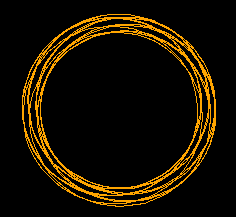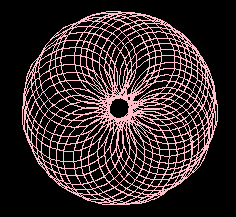
|

|
| 10000 Earth Masses | Adiabatically increased to 50000 Earth Masses |

|

|
| 10000 Earth Masses | Adiabatically increased to 50000 Earth Masses |
The key to understanding the KAM theorem is the concept of an "invariant torus".
A torus is the surface of an inner tube, a bagel, or a doughnut. Any point on the torus can be labelled by two angles. one giving the angle around the hole in the middle and the other giving the angle around the tube cylinder. Mathematicians think of it as the cross product of two circles: x^2 + y^2 = 1 and z^2 + w^2 = 1; the fact that it sits in four dimensions is unimportant to them.
You see that the Earth's trajectory looks rather like a torus: while Jupiter pushes and pulls on the Earth, and the distance to the sun depends on where Jupiter is, our trajectory is still confined on a bounded surface: our climate isn't nice, but it stays within certain extremes...
Why a torus? Think about the system in the "noninteracting planet approximation" where the masses of Earth and Jupiter are both set to zero. Earth and Jupiter both move in near-circular ellipses around the Sun. Jupiter's year is 11.862972 Earth years in this program (it's actually slightly different, but we've simplified the problem; besides, the length of Earth's year shifts with Jupiter's mass.) So, in the four dimensional space (x,y) for Earth and (X,Y) for Jupiter, the planets are approximately spiralling aroung the torus (x^2+y^2=1, X^2+Y^2=5.20316),in the four dimensional configuration space. (Or, if you prefer, in the 18 dimensional phase space of positions and velocities of Earth, Sun, and Jupiter.) Each time Jupiter rotates around the hole in the torus, Earth spirals almost 12 times around the tube ... but not quite. When we plot the Earth's orbit in the non-interacting planet approximation, we see this torus edge on, giving a circle (or ellipse). As we give Jupiter mass, the torus in phase space deforms and rotates, and the projection onto the Earth's (x,y) position fleshes out into a doughnut.
The fact that Jupiter's year is an irrational number of Earth years means that the orbit in phase space never closes on itself: it fills up the torus. This turns out to be crucial for the KAM theorem! Kolmogorov, Arnold, and Moser proved that Earth's orbit remains a torus for small Jovian masses, so long as the Jovian year was "sufficiently irrational".
Questions
As we turn the mass of Jupiter up, there must be a point at which the torus
is destroyed (the breakdown of the KAM theorem). By stepping up the mass
of Jupiter, can you find it? Does the torus ever reappear at higher masses?
 |
 |
|
James P. Sethna, sethna@lassp.cornell.edu.
![]() Statistical Mechanics: Entropy, Order Parameters, and Complexity,
now available at
Oxford University Press
(USA,
Europe).
Statistical Mechanics: Entropy, Order Parameters, and Complexity,
now available at
Oxford University Press
(USA,
Europe).